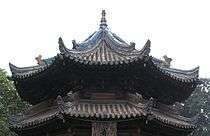Bonan people
The Bonan people (保安族, Pinyin: Bǎo'ān zú; native [bɵːŋɑn]) are an ethnic group living in Gansu and Qinghai provinces in Northwestern China. They are one of the "titular nationalities" of Gansu's Jishishan Bonan, Dongxiang and Salar Autonomous County, which is located south of the Yellow River, near Gansu's border with Qinghai.
| Total population | |
|---|---|
| 20,074 (year 2010 census) | |
| Regions with significant populations | |
| People's Republic of China, mostly concentrated in Gansu Province and a small number in Qinghai | |
| Languages | |
| Mandarin Chinese, Bonan (traditional) | |
| Religion | |
| Predominantly Sunni Islam, minority Tibetan Buddhism (Qinghai) | |
| Related ethnic groups | |
| Mongols, Dongxiang |
Numbering approximately 17,000 the Bonan are the 10th-smallest (ranked in 47th-position, out) of the 56 ethnic groups officially recognized by the People's Republic of China.
History
The Bonan people are believed to be descended from Mongol and Central Asian soldiers stationed in Qinghai during the Yuan dynasty.[1]
They are agriculturalists and also knife makers. They are mixed between Mongols, Hui, Han Chinese and Tibetans and wear Hui attire.[2]
The ancestors of today's Bonan people were Lamaist and it is known that around 1585 they lived in Tongren County (in Amdo Region; presently, in Qinghai province), north of the Tibetan Rebgong Monastery. It was in that year that the town of Bao'an was founded in that area.[3]
Later on, some of the members of the Bonan-speaking community converted to Islam and moved north, to Xunhua County. It is said that they have been converted to Islam by the Hui Sufi master Ma Laichi (1681? - 1766).[4] Later, in the aftermath of the Dungan Rebellion (1862–1874) the Muslim Bonans moved farther east, into what's today Jishishan Bonan, Dongxiang and Salar Autonomous County of Gansu Province.[3]
It were the members of this Muslim part of the original Bonan community who are officially recognized as the separate "Bonan" ethnic group in today's PRC. Their brethren who have remained Lamaists and stayed in Tongren, are now officially classified as part of the Monguor (Tu) ethnic group, even though they speak essentially the same Bonan language. The official concept of the "Bonan ethnic group" still remains somewhat artificial for the Bonans themselves.[3]
Hui, Baoan and Dongxiang troops served under Generals Ma Fulu and Ma Fuxiang in the Boxer Rebellion, defeating the invading Eight Nation Alliance at the Battle of Langfang.[5]
Hui, Baoan, Dongxiang, Salar and Tibetan troops served under Ma Biao in the Second Sino-Japanese War against the Japanese.[6][7]
Language
| Part of a series on Islam in China | ||||||
|---|---|---|---|---|---|---|
 | ||||||
|
||||||
|
| ||||||
Both the Muslim Bonans in Gansu and their Buddhist cousins in Qinghai (officially classified as Monguor) have historically spoken the Bonan language, a Mongolic language. The Buddhist Bonan of Qinghai speak a slightly different dialect than the Muslim Bonan of Gansu. Whereas the Bonan language of Gansu has undergone Chinese influences, the Bonan language of Qinghai has been influenced by Tibetan.[3] The language is also closely related to archaic versions of Mongolian.[1]
They have no script for their language.[8]
The Muslim Gansu Bonans are more numerous than their Buddhist Qinghai cousins (the estimates for the two groups were around 12,200 (in 1990), and around 3,500 (in 1980), respectively). However, it has been observed that in Gansu the use of Bonan language is declining (in favor of the local version – the "Hezhou dialect" – of Mandarin Chinese), while in Qinghai the language keeps being transmitted to younger generations.[3]
Genetics
Distribution of Y-chromosome haplogroups in Bonan:[9]
- O=23.43(O2=20.31,O1a=1.56,O1b=1.56)
- J=18.75
- R1=14.07(R1a=10.94,R1b=3.13)
- C=9.37
- N=9.17
- R2=6.25
- D=6.25
- I=4.69
- Others=8.02
In another study in 2010 found:[10]
Culture
The Bonan share many traditions with the Dongxiang and Hui. Their traditional dress includes elements of Tibetan, Hui and Dongxiang clothing. Married Bonan women wear black veils, while unmarried women wear green veils. Women wear more colorful dress, including trousers with colored cuffs. Bonan men typically wear black or white skullcaps and white or dark blue jackets. Fur-lined jackets are used during the winter.[11]
The economy of the Bonan consists of farming (mainly wheat and rye), raising livestock, selling local handicrafts, and working in the lumber industry. Bonan knives are renowned for their beauty and hardness and their manufacture and sale also form an important part of the local economy.[11]
Popular pastimes for the Bonan include horse-riding, wrestling, and archery. The Bonan also enjoy poetry, singing, dancing, and playing traditional Chinese instruments.[11]
References
- Dillon, Michael (1996). China's Muslims. Hong Kong: Oxford University Press. pp. 12. ISBN 0195875044.
- Shoujiang Mi, Jia You (2004). Islam in China. 五洲传播出版社. p. 58. ISBN 978-7-5085-0533-6. Retrieved 2010-06-28.
- Janhunen, Juha (2003). The Mongolic languages. Volume 5 of Routledge language family series. Routledge. pp. 325–326. ISBN 978-0-7007-1133-8.
- Lipman, Jonathan Neaman (1998). Familiar strangers: a history of Muslims in Northwest China. Hong Kong University Press. p. 67. ISBN 978-962-209-468-0. Lipman's source is a book by Ma Tong.
- "抗击八国联军的清军将领——马福禄 - 360Doc个人图书馆". Archived from the original on 2018-12-14. Retrieved 2014-10-30.
- "马家军悲壮的抗战:百名骑兵集体投河殉国(1)". 军事-中华网. 19 September 2008. Archived from the original on 2011-04-11. Retrieved 2014-10-30.
- "民国少数民族将军(组图)2 - 360Doc个人图书馆". Archived from the original on 2018-12-14. Retrieved 2014-10-30.
- Shoujiang Mi, Jia You (2004). Islam in China. 五洲传播出版社. p. 57. ISBN 978-7-5085-0533-6. Retrieved 2010-06-28.
- Wen, Shaoqing; Xu, Dan (2017), "The Silk Road: Language and Population Admixture and Replacement" (PDF), Languages and Genes in Northwestern China and Adjacent Regions, Springer, Singapore, pp. 55–78, doi:10.1007/978-981-10-4169-3_4, ISBN 9789811041686
- Xiao, Chun-Jie; Tang, Wen-Ru; Shi, Hong; Tan, Si-Jie; Dong, Yong-Li; Wei, Chuan-Yu; Qiao, En-Fa; Shou, Wei-Hua (May 2010). "Y-chromosome distributions among populations in Northwest China identify significant contribution from Central Asian pastoralists and lesser influence of western Eurasians". Journal of Human Genetics. 55 (5): 314–322. doi:10.1038/jhg.2010.30. ISSN 1435-232X. PMID 20414255.
- Elliot, Sheila Hollihan (2006). Muslims in China. Philadelphia: Mason Crest Publishers. pp. 68–69. ISBN 1-59084-880-2.